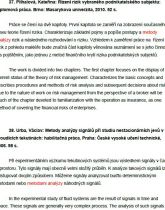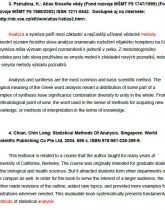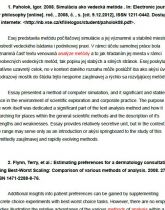Semestrálna práca: Rešerš - menódy analýzy - analytické metódy
Skryť detaily | Obľúbený- Kvalita:82,5 %
- Typ:Semestrálna práca
- Univerzita:Technická univerzita v Košiciach
- Fakulta:Fakulta baníctva, ekológie, riadenia a geotechnológií
- Kategória:Technika
- Podkategória:Baníctvo
- Predmet:Teória logistiky
- Študijný program:Priemyselná logistika
- Autor:adam.b
- Ročník:1. ročník
- Rozsah A4:13 strán
- Zobrazené:2 066 x
- Stiahnuté:1 x
- Veľkosť:0,1 MB
- Formát a prípona:MS Office Word (.docx)
- Jazyk:slovenský
- ID projektu:44886
- Posledna úprava:10.03.2014
1. Paholok, Igor. 2008. Simulácia ako vedecká metóda . In: Electronic journal
for philosophy [online]. roč. , 2008, č. , s. [cit. 9.12.2012], ISSN 1211-0442. Dostupné
na internete: <http://nb.vse.cz/kfil/elogos/student/paholok08.pdf>.
Esej predstavila metodu počitačovej simulacie a jej vyznamne a stabilne miesto v
prostredi vedeckeho badania i podnikovej praxi. V ramci učelu samotnej prace bola
vyznamna časť textu venovana analyze metody a to jak hľadanim jej miesta v ramci
všeobecnych vedeckych metod, tak popisu jej slabych a silnych stranok. Esej poskytuje
relativne uzavrety celok, no v kontext daneho rozsahu može poslužiť iba ako akysi uvod
či odrazovy mostik do študia tejto nesporne zaujimavej a rychlo sa rozvijajucej metody.
Essay presented a method of computer simulation, and it significant and stable
place in the environment of scientific exploration and corporate practice. The purpose of
the work itself was dedicated a significant part of the text analysis method and how it
searching for places within the general scientific methods and the description of it's
strengths and weaknesses. Essay provides relatively secretive unit, but in the context of
the range may serve only as an introduction or akysi springboard to the study of this
admittedly zaujimavej and rapidly evolving methods.
2. Flynn, Terry, et al.: Estimating preferences for a dermatology consultation
using Best-Worst Scaling: Comparison of various methods of analysis. 2008. 27 s.
ISBN 1471-2288-8-76.
Additional insights into patient preferences can be gained by supplementing
discrete choice experiments with best-worst choice tasks. However, there are no empirical
studies illustrating the relative advantages of the various methods of analysis within a
random utility framework.
Ďalši pohľad do pacientovych preferencii možno ziskať doplnenim diskretnej voľby
experimenov s najlepšimi a najhoršimi ulohami vyberu. Avšak, nie su tam žiadne
empiricke študie ilustrujuce relativne vyhody roznych metod analyzy v nahodnom užitkom
ramci.
for philosophy [online]. roč. , 2008, č. , s. [cit. 9.12.2012], ISSN 1211-0442. Dostupné
na internete: <http://nb.vse.cz/kfil/elogos/student/paholok08.pdf>.
Esej predstavila metodu počitačovej simulacie a jej vyznamne a stabilne miesto v
prostredi vedeckeho badania i podnikovej praxi. V ramci učelu samotnej prace bola
vyznamna časť textu venovana analyze metody a to jak hľadanim jej miesta v ramci
všeobecnych vedeckych metod, tak popisu jej slabych a silnych stranok. Esej poskytuje
relativne uzavrety celok, no v kontext daneho rozsahu može poslužiť iba ako akysi uvod
či odrazovy mostik do študia tejto nesporne zaujimavej a rychlo sa rozvijajucej metody.
Essay presented a method of computer simulation, and it significant and stable
place in the environment of scientific exploration and corporate practice. The purpose of
the work itself was dedicated a significant part of the text analysis method and how it
searching for places within the general scientific methods and the description of it's
strengths and weaknesses. Essay provides relatively secretive unit, but in the context of
the range may serve only as an introduction or akysi springboard to the study of this
admittedly zaujimavej and rapidly evolving methods.
2. Flynn, Terry, et al.: Estimating preferences for a dermatology consultation
using Best-Worst Scaling: Comparison of various methods of analysis. 2008. 27 s.
ISBN 1471-2288-8-76.
Additional insights into patient preferences can be gained by supplementing
discrete choice experiments with best-worst choice tasks. However, there are no empirical
studies illustrating the relative advantages of the various methods of analysis within a
random utility framework.
Ďalši pohľad do pacientovych preferencii možno ziskať doplnenim diskretnej voľby
experimenov s najlepšimi a najhoršimi ulohami vyberu. Avšak, nie su tam žiadne
empiricke študie ilustrujuce relativne vyhody roznych metod analyzy v nahodnom užitkom
ramci.



